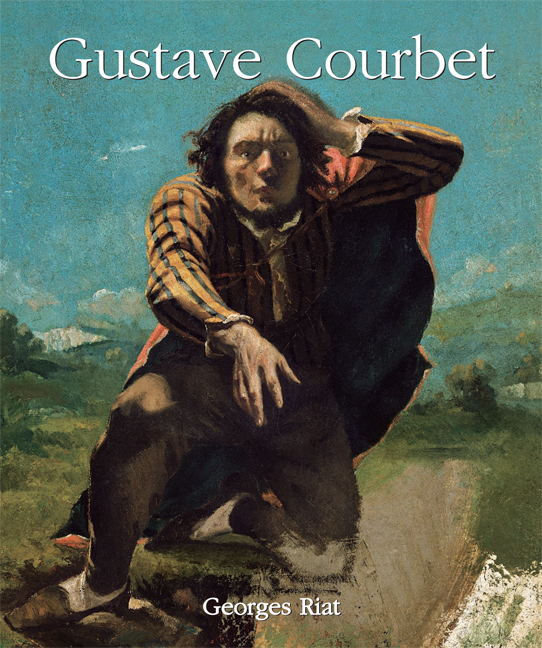Электронная книга: Georges Riat «Gustave Courbet»

|
Серия: "Temporis" Ornans, Courbet’s birthplace, is near the beautiful valley of the Doubs River, and it was here as a boy, and later as a man, that he absorbed the love of landscape. He was by nature a revolutionary, a man born to oppose existing order and to assert his independence; he had that quality of bluster and brutalitywhich makes the revolutionary count in art as well as in politics. In both directions his spirit of revolt manifested itself. He went to Paris to study art, yet he did not attach himself to the studio of any of the prominent masters. Already in his country home he had had a little instruction in painting, and preferred to study the masterpieces of the Louvre. At first his pictures were not sufficiently distinctive to arouse any opposition, and were admitted to the Salon. Then followed the Funeral at Ornans, which the critics violently assailed: “A masquerade funeral, six metres long, in which there is more to laugh at than to weep over.” Indeed, the real offence of Courbet’s pictures was that they represented live flesh and blood. They depicted men and women as they really are and realistically doing the business in which they are engaged. His figures were not men and women deprived of personality and idealised into a type, posed in positions that will decorate the canvas. He advocated painting things as they are, and proclaimed that la v?rit? vraie must be the aim of the artist. So at the Universal Exposition of 1855 he withdrew his pictures from the exhibition grounds and set them in a wooden booth, just outside the entrance. Over the booth he posted a sign with large lettering. It read, simply: “Courbet – Realist.” Like every revolutionary, he was an extremist. He ignored the fact that to every artist the truth of nature appears under a different guise according to his way of seeing and experiencing. Instead, he adhered to the notion that art is only a copying of nature and not a matter also of selection and arrangement. In his contempt for prettiness Courbet often chose subjects which may fairly be called ugly. But that he also had a sense of beauty maybe seen in his landscapes. That sense, mingled with his capacity for deep emotion, appears in his marines – these last being his most impressive work. Moreover, in all his works, whether attractive or not to the observer, he proved himself a powerful painter, painting in a broad, free manner, witha fine feeling for colour, and with a firmness of pigment that made all his representations very real and stirring. Издательство: "Parkstone International Publishing"
ISBN: 978-1-78042-990-8 электронная книга |
Другие книги схожей тематики:
| Автор | Книга | Описание | Год | Цена | Тип книги |
|---|---|---|---|---|---|
| Gustave Courbet | Published for an exhibition at the Fondation Beyeler, this volume concentrates on Gustav Courbet's position as the first avant-garde painter. With his provocative canvases and his emphasis on the… — Hatje Cantz Verlag, - Подробнее... | 2014 | 1904 | бумажная книга | |
| Gustave Courbet | Published for an exhibition at the Fondation Beyeler, this volume concentrates on Gustav Courbet`s position as the first avant-garde painter. With his provocative canvases and his emphasis on the… — Hatje Cantz Verlag, Подробнее... | 2015 | 2393 | бумажная книга | |
| Фабрис Масанес | Courbet | От издателя: "I maintain," stated Gustave Courbet (1819-1877)," that painting is clearly a concrete art whose existence lies only in the representation of real and existing objects..."… — (формат: 185х230 мм, 96стр. (цветные иллюстрации) стр.) Подробнее... | 2006 | 330 | бумажная книга |
| Richard Johns, Christine Riding | Turner and the Sea | This is the first publication to focus on J. M. W. Turner’s lifelong fascination with the sea, from his Royal Academy debut in 1796, Fishermen at Sea, to his iconic maritime subjects of the 1830s… — Thames and Hudson Limited, (формат: 250x310, 288 стр.) Подробнее... | 2013 | 5990 | бумажная книга |
| Роланд Канц | Portraits | От издателя:Beginning in the 14th century and working its way through the ages up to the current day, this book examines the portrait via the most beloved and important examples in history… — (формат: 185x230мм, 96стр. (цветные иллюстрации) стр.) Back to visual basics Подробнее... | 2008 | 330 | бумажная книга |
| Jones Caroline A. | Global Work of Art | Global biennials have proliferated in the contemporary art world, but artists'engagement with large-scale international exhibitions has a much longer history that has influenced the present in… — Chicago University Press, - Подробнее... | 2017 | 5335 | бумажная книга |
| Color and Light. The Neo-Impressionist Henri-Edmond Cross | Inspired by the work of Realist painters such as Gustave Courbet and Francois Bonvin, Henri Edmond Cross's earliest paintings were compositions in dark, somber colors. Following his involvement with… — Prestel, - Подробнее... | 2018 | 4489 | бумажная книга |
См. также в других словарях:
Gustave Courbet — Nacimiento … Wikipedia Español
Gustave Courbet — Fotografie von Nadar Jean Désiré Gustave Courbet (* 10. Juni 1819 in Ornans bei Besançon; † 31. Dezember 1877 in La Tour de Peilz/Schweiz) war ein französischer Maler des … Deutsch Wikipedia
Gustave Courbet — For other uses, see Courbet (disambiguation). Gustave Courbet Gustave Courbet (portrait by Nadar). Birth name Jean Désiré Gustave Courbet … Wikipedia
Gustave Courbet — Pour les articles homonymes, voir Courbet. Gustave Courbet Gustave Courbet photographié par Nadar … Wikipédia en Français
Gustave Courbet — noun French painter noted for his realistic depiction of everyday scenes (1819 1877) • Syn: ↑Courbet • Instance Hypernyms: ↑painter … Useful english dictionary
Rue Gustave-Courbet — 16e arrt … Wikipédia en Français
